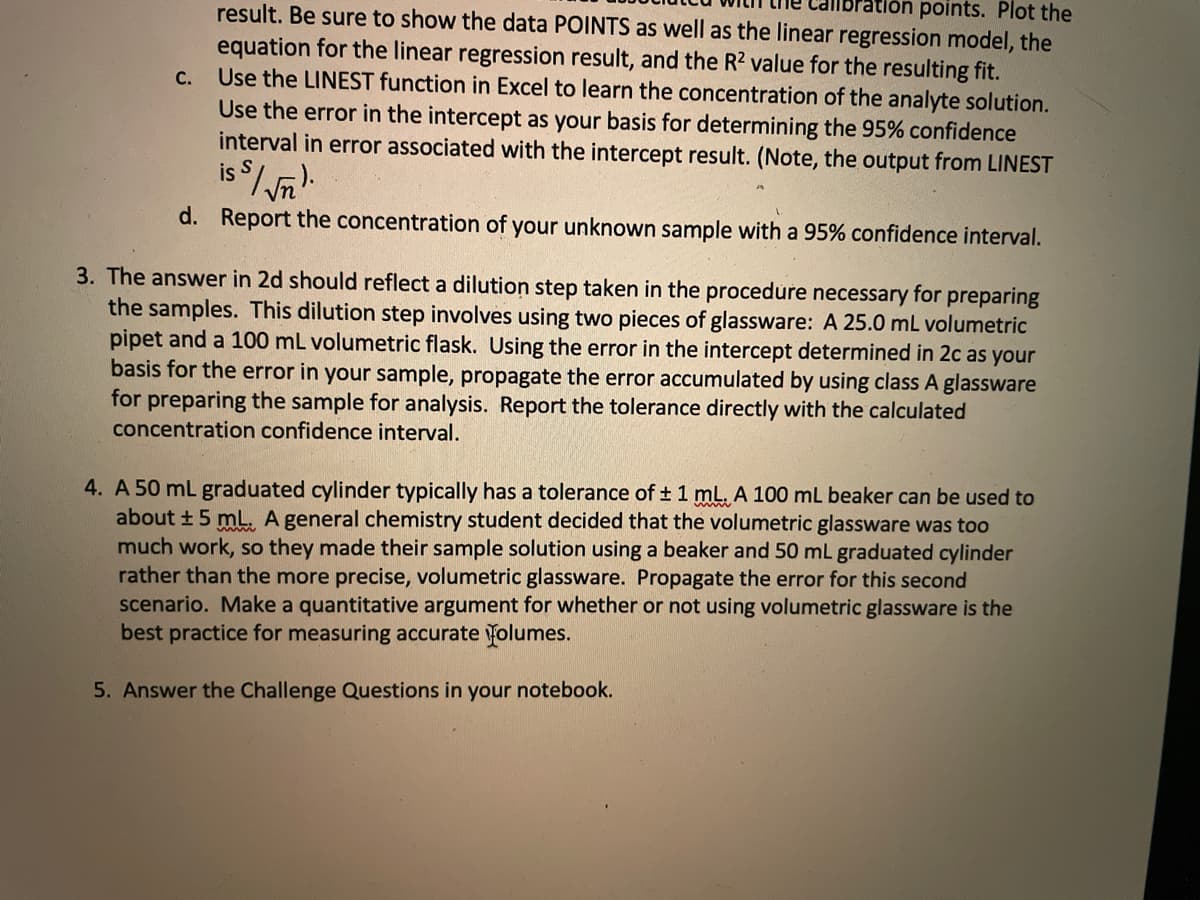we dilute unknown sample of 25ml to 100ml And want to find error propagation associated with it. The unknown sample concentration is :1.2984 ppm Error: .1958 Class A 25 ml pipet error : .03ml Class A 100ml beaker : .08 I find the unknown concentration but need error associated with it during dilution process Any hints?
we dilute unknown sample of 25ml to 100ml And want to find error propagation associated with it. The unknown sample concentration is :1.2984 ppm Error: .1958 Class A 25 ml pipet error : .03ml Class A 100ml beaker : .08 I find the unknown concentration but need error associated with it during dilution process Any hints?
Chapter14: Chromatography
Section: Chapter Questions
Problem 9P
Related questions
Question
100%
Q3 we dilute unknown sample of 25ml to 100ml
And want to find error propagation associated with it.
The unknown sample concentration is :1.2984 ppm
Error: .1958
Class A 25 ml pipet error : .03ml
Class A 100ml beaker : .08
I find the unknown concentration but need error associated with it during dilution process
Any hints?

Transcribed Image Text:ation points. Plot the
result. Be sure to show the data POINTS as well as the linear regression model, the
equation for the linear regression result, and the R2 value for the resulting fit.
Use the LINEST function in Excel to learn the concentration of the analyte solution.
Use the error in the intercept as your basis for determining the 95% confidence
interval in error associated with the intercept result. (Note, the output from LINEST
is $/ n
C.
d. Report the concentration of your unknown sample with a 95% confidence interval.
3. The answer in 2d should reflect a dilution step taken in the procedure necessary for preparing
the samples. This dilution step involves using two pieces of glassware: A 25.0 mL volumetric
pipet and a 100 mL volumetric flask. Using the error in the intercept determined in 2c as your
basis for the error in your sample, propagate the error accumulated by using class A glassware
for preparing the sample for analysis. Report the tolerance directly with the calculated
concentration confidence interval.
4. A 50 mL graduated cylinder typically has a tolerance of 1 mL. A 100 mL beaker can be used to
about +5 mL. A general chemistry student decided that the volumetric glassware was too
much work, so they made their sample solution using a beaker and 50 mL graduated cylinder
rather than the more precise, volumetric glassware. Propagate the error for this second
scenario. Make a quantitative argument for whether or not using volumetric glassware is the
best practice for measuring accurate folumes.
5. Answer the Challenge Questions in your notebook.
Expert Solution
This question has been solved!
Explore an expertly crafted, step-by-step solution for a thorough understanding of key concepts.
This is a popular solution!
Trending now
This is a popular solution!
Step by step
Solved in 5 steps

Knowledge Booster
Learn more about
Need a deep-dive on the concept behind this application? Look no further. Learn more about this topic, chemistry and related others by exploring similar questions and additional content below.Recommended textbooks for you



Principles of Instrumental Analysis
Chemistry
ISBN:
9781305577213
Author:
Douglas A. Skoog, F. James Holler, Stanley R. Crouch
Publisher:
Cengage Learning



Principles of Instrumental Analysis
Chemistry
ISBN:
9781305577213
Author:
Douglas A. Skoog, F. James Holler, Stanley R. Crouch
Publisher:
Cengage Learning